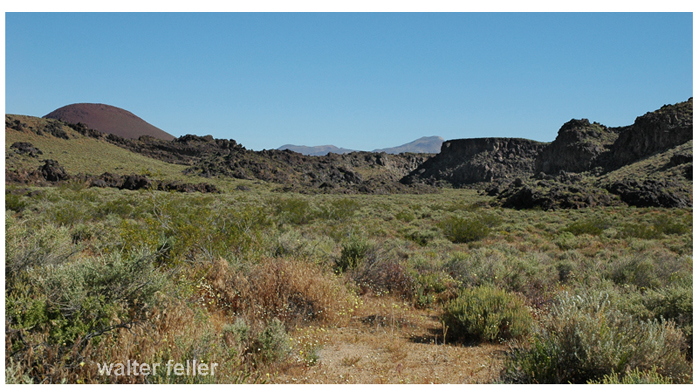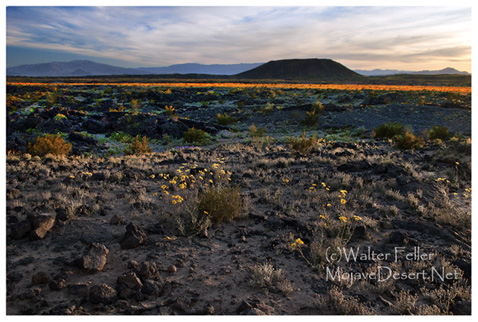Volcanic Rocks, Cinder Cones and Lava Fields
Volcanic eruptions don't occur everywhere. Several "ingredients" must combine at the right place and time. While geologic complexities of Southern California are still under investigation, many researchers think that faulting, block movement, and associated magma production are key ingredients contributing to the formation of cinder cones and lava flows in the Mojave Desert.
Fossil Falls as viewed from Little Lake
During the Mesozoic Era (~245-65 million years ago), extensive tectonic activity in western North America resulted in a dynamic period of volcanism and faulting as the Pacific Plate began to slide beneath the North American Plate. Then, around 30 million years ago, great fault systems developed further throughout present-day California. Regional movement of these faults cracked the earth's crust into blocks.
As the plates and blocks of the earth's crust slide and rotate, they generate friction and and tremendous heat. Beneath the Mojave, rocks of the lower crust melted. Because it is less dense than the surrounding rock, the melted, mantle-derived basalt or magma, rises toward the surface. When magma cannot find a path upwards it pools into magma chambers. The chambers can be huge, providing enough magma for many volcanos over several years. To form a volcano, however, magma must reach the surface.
The spaces between fault blocks are zones of weakness reaching down to the mantle. Pressure within magma chambers was released as eruptions through such fractures or vents in the earth's crust , providing magma with a way up and out. With this final ingredient, a hot and "fresh" volcano is formed.
| GLOSSARY | > basalt, igneous, lava, magma, obsidian, |
More about >
Volcanic Rocks and Associated Landforms
Examples of landform features associated with modern and ancient volcanism. A volcano forms at an site where erupted material builds up (including lava flows, cinders, and ash). Over time, weathering and erosion ...Volcanic Fields
Information on volcanic fields from Mono Lake south to Lavic Lake in the Mojave Desert.source: NPS
Cinder Cones National Natural Landmark
The skyline of Cima Dome is interrupted by the conical outlines of dozens of remarkably well-preserved ...Lava Tube
Amboy Crater
Amboy Crater, formed of ash and cinders, is 250 feet high and 1,500 feet in diameter. The crater is in ...Pisgah Crater
Lava Tube
Ubehebe Crater
Maar volcanoes formed by steam and gas explosions around 3,000 years ago created when hot magma reached ...
Amboy Crater
